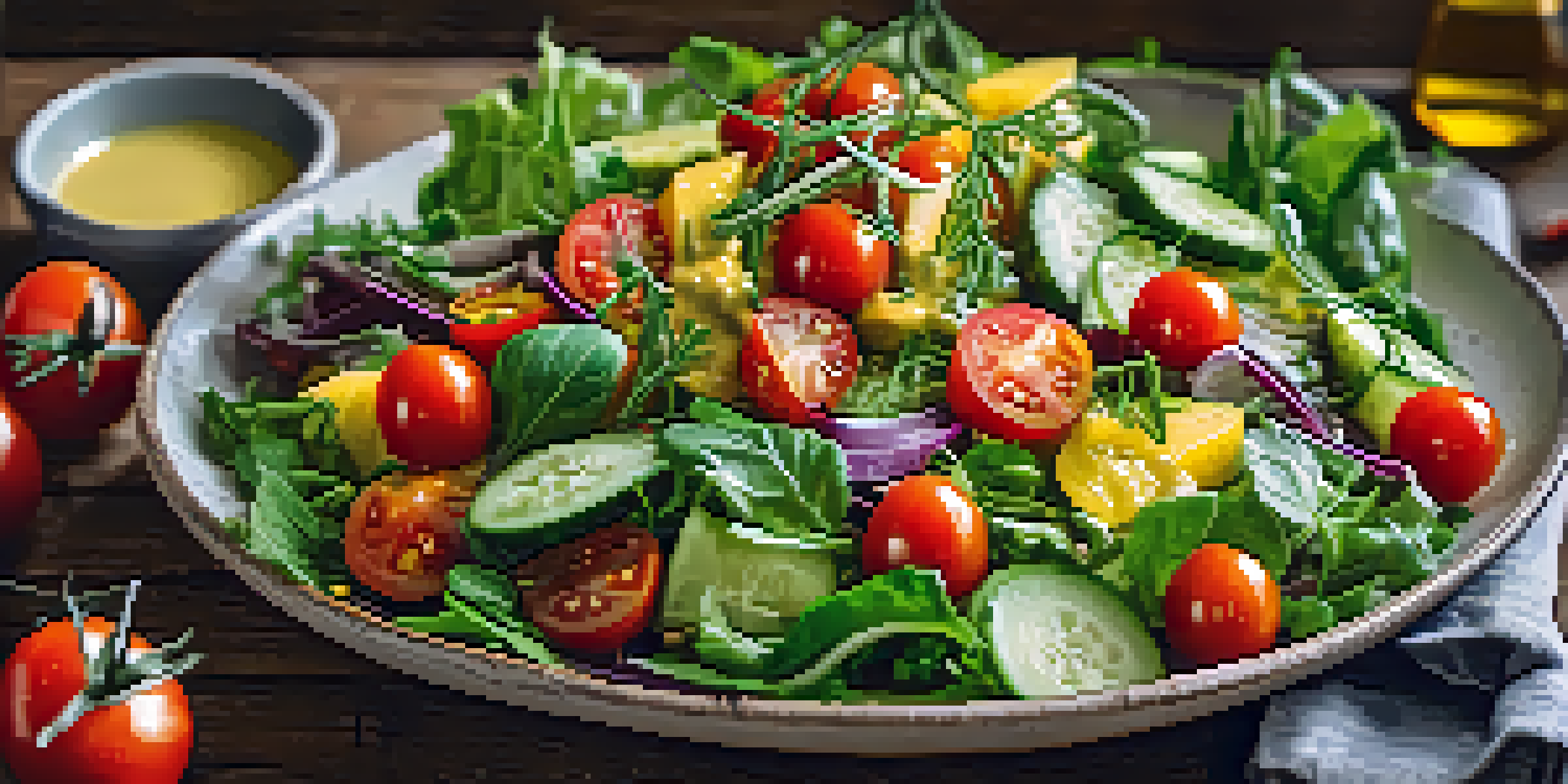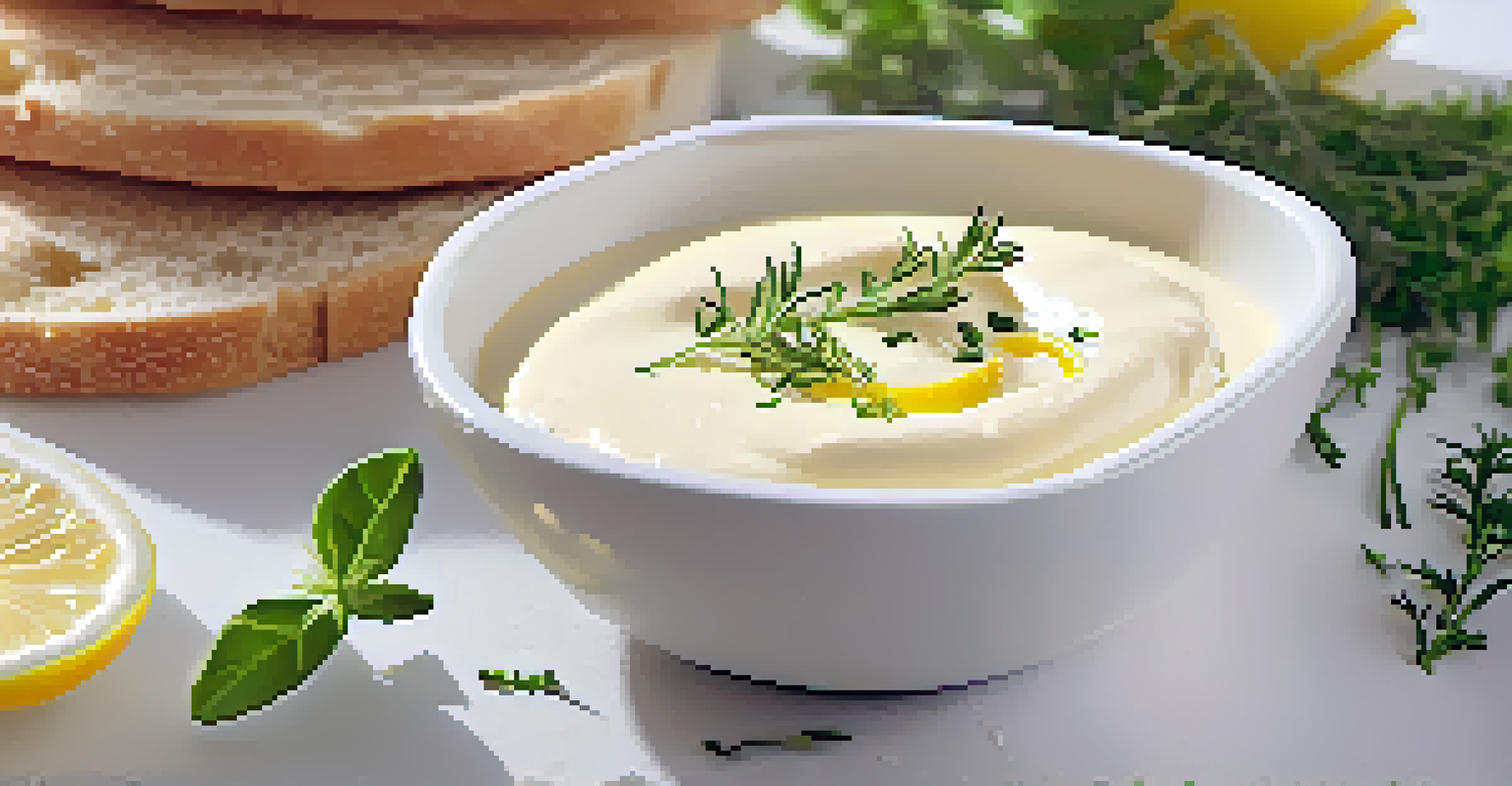The Role of Emulsification in Vegan Sauces and Dressings

What is Emulsification and Why Does It Matter?
Emulsification is the process of mixing two liquids that typically don’t blend well, like oil and water. This technique is crucial in cooking, particularly for creating smooth, creamy textures in sauces and dressings. Without emulsification, many vegan sauces would separate, leading to an unappetizing appearance and uneven flavor.
Cooking is like love. It should be entered into with abandon or not at all.
Imagine trying to combine salad dressing ingredients like olive oil and vinegar. Without emulsification, they would quickly separate, ruining the dressing's consistency. In vegan cooking, achieving that perfect blend enhances both the visual appeal and mouthfeel of the dish.
Understanding emulsification allows vegan chefs to create deliciously cohesive sauces that elevate their culinary creations. This technique not only improves aesthetics but also ensures a harmony of flavors in every bite.
Common Emulsifiers Used in Vegan Sauces
In the world of vegan cooking, common emulsifiers include ingredients like mustard, aquafaba, and soy lecithin. Mustard adds a unique flavor while helping to stabilize oil and vinegar mixtures, making it a popular choice for dressings. Aquafaba, the liquid from chickpeas, can also create a creamy texture, perfect for mayo or creamy sauces.

Soy lecithin, derived from soybeans, is another powerful emulsifier that helps blend oil and water-based ingredients seamlessly. It’s often used in commercial vegan products, but home chefs can incorporate it into their recipes too. These emulsifiers not only enhance texture but also introduce exciting flavors.
Emulsification Creates Cohesive Sauces
This technique blends oil and water to enhance texture and flavor in vegan cooking.
Choosing the right emulsifier can significantly impact the success of your vegan sauce. By experimenting with different options, you can discover new tastes and textures that elevate your dishes.
The Science Behind Emulsification
At its core, emulsification involves breaking down fat molecules and dispersing them throughout a liquid, creating a stable mixture. This process is facilitated by emulsifiers that have both hydrophilic (water-loving) and hydrophobic (water-repelling) properties. These unique characteristics allow emulsifiers to bridge the gap between oil and water.
The secret of good cooking is, first, having a good plate, and second, a good sauce.
Think of emulsifiers as tiny mediators that bring two opposing forces together. They wrap around fat droplets, preventing them from clumping together and allowing for a smooth blend. This scientific principle is the foundation of many beloved sauces and dressings.
Understanding the science behind emulsification not only boosts your culinary skills but also empowers you to innovate in the kitchen. By mastering this technique, you can create vegan sauces that are both delicious and visually appealing.
Techniques for Successful Emulsification
To achieve successful emulsification, it's essential to add ingredients in the right order. Start by combining your emulsifier with the aqueous component, like vinegar or lemon juice, before slowly drizzling in the oil. This gradual incorporation helps create a stable emulsion.
Another useful technique is to use a blender or food processor, which provides consistent mixing and aeration. This not only speeds up the emulsification process but also incorporates air, enhancing the sauce's volume and lightness. For those who prefer a hands-on approach, whisking vigorously can also yield good results.
Common Vegan Emulsifiers Explained
Ingredients like mustard, aquafaba, and soy lecithin serve as effective emulsifiers in vegan sauces.
Experimenting with different techniques can lead to delicious surprises in your sauces. Whether you choose to blend, whisk, or shake, finding the right method will help you create emulsified sauces that impress.
Common Mistakes in Emulsification
One common mistake in emulsification is adding oil too quickly, which can lead to separation. It's crucial to introduce oil gradually while mixing to ensure a stable emulsion forms. If you pour the oil in too fast, it overwhelms the emulsifier, resulting in a lumpy mixture.
Another pitfall is not using a proper emulsifier. Skipping this step can leave your sauce looking and tasting unappealing. Always include an emulsifier to help bind your ingredients together for a smooth finish.
By being aware of these common mistakes, you can refine your emulsification skills. Learning from these errors will help you produce perfect vegan sauces every time.
Flavor Enhancements Through Emulsification
Emulsification not only improves texture but also enhances flavor in sauces and dressings. When oil and water are properly blended, the flavors of each ingredient meld together, creating a more cohesive taste. This is especially important in vegan cooking, where the right balance of flavors can elevate a dish.
For instance, adding fresh herbs or spices to an emulsified dressing can result in a vibrant, flavorful experience. The emulsification process helps distribute these flavors evenly, ensuring every bite is packed with taste. This is a game-changer for salads and marinades alike.
Avoiding Emulsification Mistakes
Gradually adding oil and using proper emulsifiers are key to achieving successful emulsification.
By mastering emulsification, you can explore countless flavor combinations in your vegan sauces. This technique opens up a world of culinary possibilities that can make your dishes truly memorable.
Creative Vegan Sauce Ideas Using Emulsification
With emulsification in your culinary toolkit, the possibilities for vegan sauces are endless. Take a classic vinaigrette, for example: by using mustard as an emulsifier, you can create a tangy dressing that complements any salad. Adding herbs or garlic can further enhance the flavor profile.
Another exciting option is to whip up a vegan aioli using aquafaba, garlic, and lemon juice. This creamy sauce can be used as a dip or spread, showcasing the versatility of emulsification. The airy texture and rich flavor make it a crowd-pleaser, perfect for gatherings.

Exploring different emulsified sauces can inspire creativity in your cooking. From creamy dressings to zesty dips, there's a whole world of vegan sauces waiting to be discovered.